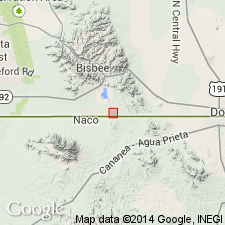
- Usage in publication:
-
- Joserita member
- Modifications:
-
- Original reference
- Biostratigraphic dating
- Dominant lithology:
-
- Dolomite
- Grit
- Sandstone
- Limestone
- Shale
- AAPG geologic province:
-
- Pedregosa basin
Summary:
Pg. 11-12, 15, 36 (table 6), pl. 27. Joserita member of Lowell formation of Bisbee group. Consists of following divisions (ascending): (8h) soft sandstone and arenaceous shale, 34 feet; (8g) gray shaly limestone, 2 feet; (8f) soft shale and sandstone, 35 feet; (8e) Baga shale and limestone (new), 7 feet; (8d) yellow dolomite, 3 feet; (8c) Espinal grit (new), average 4 feet; (8b) Corta sandstone (new), 35 feet; and (8a) Quimbo dolomite (new), 3 feet. Total thickness 123 feet. Underlies Saavedra member (new) and overlies Pacheta member (new); both of Lowell formation. Fossils (notably ammonites DUFRENOYA JOSERITA sp. nov., and PARACANTHOHOPLITES MERIDIONALIS, gen. and sp. nov.). Age is Early Cretaceous (Aptian); PARAHOPLITES MELCHIORIS (divisions 8h to 8e) to DUFRENOYA DUFRENOYI (divisions 8d to 8a) standard ammonite zone.
[Occurs in the Ninety One Hills area, local name for hills in secs. 14 and 23, T. 24 S., R. 24 E., immediately north of International border in vicinity of International Monument No. 91, southeast of Bisbee Junction on Southern Pacific RR, Bisbee 15-min quadrangle, Cochise Co., southeastern AZ. Area includes type locality and standard section of Lowell Formation.]
Source: Publication; US geologic names lexicon (USGS Bull. 1200, p. 1942-1943).
For more information, please contact Nancy Stamm, Geologic Names Committee Secretary.
Asterisk (*) indicates published by U.S. Geological Survey authors.
"No current usage" (†) implies that a name has been abandoned or has fallen into disuse. Former usage and, if known, replacement name given in parentheses ( ).
Slash (/) indicates name conflicts with nomenclatural guidelines (CSN, 1933; ACSN, 1961, 1970; NACSN, 1983, 2005, 2021). May be explained within brackets ([ ]).

